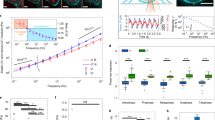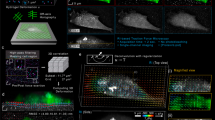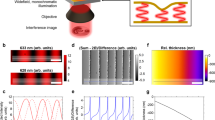Abstract
It is unclear whether cell division is driven by cortical relaxation outside the equatorial region or cortical contractility within the developing furrow alone. To approach this question, a technique is required that can monitor spatially-resolved changes in cortical stiffness with good time resolution. We employed atomic force microscopy (AFM), in force-mapping mode, to track dynamic changes in the stiffness of the cortex of adherent cultured cells along a single scan-line during M phase, from metaphase to cytokinesis. Video microscopy, which we used to correlate the AFM data with mitotic events identified by light microscopy, indicated that the AFM force-mapping technique does not perturb dividing cells. Here we show that cortical stiffening occurs over the equatorial region about 160 seconds before any furrow appears, and that this stiffening markedly increases as the furrow starts. By contrast, polar relaxation of cells does not seem to be an obligatory event for cell division to occur.
This is a preview of subscription content, access via your institution
Access options
Subscribe to this journal
Receive 12 print issues and online access
$209.00 per year
only $17.42 per issue
Buy this article
- Purchase on Springer Link
- Instant access to full article PDF
Prices may be subject to local taxes which are calculated during checkout




Similar content being viewed by others
References
Glotzer, M. Curr. Opin. Cell Biol. 9, 815–823 (1997).
Robinson, D. N. & Spudich, J. A. Trends Cell Biol. 10, 228–237 (2000).
Wolf, W. A., Chew, T.-L. & Chisholm, R. L. Cell. Mol. Life Sci. 55, 108–120 (1999).
Rappaport, R. Intl Rev. Cytol. 31, 169–213 (1971).
Wolpert, L. Intl Rev. Cytol. 10, 163–216 (1960).
White, J. G. & Borisy, G. G. J. Theor. Biol. 101, 289–316 (1983).
Harris, A. K. NATO ASI Series H 84, 37–66 (1994).
Binnig, G., Quate, C. F. & Gerber, C. Phys. Rev. Lett. 56, 930–933 (1986).
Radmacher, M., Cleveland, J. P., Fritz, M., Hansma, H. G. & Hansma, P. K. Biophys. J. 66, 2159–2165 (1994).
Radmacher, M. IEEE Eng. Med. Biol. 16, 47–57 (1997).
Rotsch, C., Jacobson, K. & Radmacher, M. Proc. Natl Acad. Sci. USA 96, 921–926 (1999).
Dvorak, J. A. & Nagao, E. Exp. Cell Res. 242, 69–74 (1998).
Fishkind, D. J. & Wang, Y.-l. J. Cell Biol. 123, 837–848 (1993).
Cao, L.-g. & Wang, Y.-l. J. Cell Biol. 111, 1905–1911 (1990).
Sanger, J. M. & Sanger, J. W. Microscopy Res. Techn. 49, 190–201 (2000).
Fishkind, D. J. & Wang, Y.-l. Curr. Opin. Cell Biol. 7, 23–31 (1995).
Cao, L.-g. & Wang, Y.-l. Mol. Biol. Cell 7, 225–232 (1996).
Burton, K. & Taylor, L. Nature 385, 450–454 (1997).
Butt, H.-J. & Jaschke, M. Nanotechnology 6, 1–7 (1995).
Domke, J. et al. Colloids and Surfaces B: Biointerfaces 19, 367–379 (2000).
Domke, J. & Radmacher, M. Langmuir 14, 3320–3325 (1998).
Radmacher, M., Fritz, M., Kacher, C. M., Cleveland, J. P. & Hansma, P. K. Biophys. J. 70, 556–567 (1996).
Sneddon, I. N. Int. J. Eng. Sci. 3, 47–57 (1965).
Acknowledgements
We thank J. Canman, A. Harris and T. Salmon (University of North Carolina, Chapel Hill), Y. Wang (University of Massachusetts), and J. White (University of Wisconsin) for advice. We also thank B. Bement (University of Wisconsin-Madison) and D. Fishkind (University of Notre Dame) for criticism. We thank S. Bolz and T. Gloe (Ludwig-Maximilians University) for help with confocal microscopy and A. Kardinal for technical assistance. K.J. also thanks H. Gaub (Ludwig-Maximilians University) for hospitality. This work was partially supported by an NIH grant (to K.J.) and by the Deutsche Forschungs-meinscraft (to R.M. and M.R.).
Author information
Authors and Affiliations
Corresponding author
Rights and permissions
About this article
Cite this article
Matzke, R., Jacobson, K. & Radmacher, M. Direct, high-resolution measurement of furrow stiffening during division of adherent cells. Nat Cell Biol 3, 607–610 (2001). https://doi.org/10.1038/35078583
Received:
Revised:
Accepted:
Published:
Issue Date:
DOI: https://doi.org/10.1038/35078583
This article is cited by
-
Monitoring the mass, eigenfrequency, and quality factor of mammalian cells
Nature Communications (2024)
-
Spatiotemporal dynamics of single cell stiffness in the early developing ascidian chordate embryo
Communications Biology (2021)
-
Inhibition of polar actin assembly by astral microtubules is required for cytokinesis
Nature Communications (2021)
-
Force spectroscopy of single cells using atomic force microscopy
Nature Reviews Methods Primers (2021)
-
Scanning probe microscopy
Nature Reviews Methods Primers (2021)



